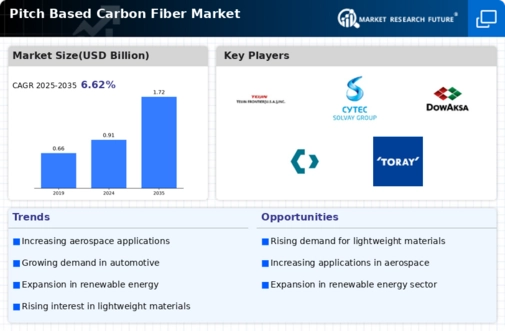Market Share
Pitch Based Carbon Fiber Market Share Analysis
Automobile manufacturers worldwide are embracing a new trend—creating lighter cars. The reason behind this shift is the increasing regulations mandating cars to emit fewer pollutants. Even a small reduction in a car's weight, around 10%, can result in a significant 6-8% decrease in fuel consumption. This not only enhances fuel efficiency but is crucial for minimizing the pollution emitted by cars, addressing a pressing need in today's environmentally conscious landscape.
A remarkable solution to achieve lighter cars involves the use of carbon fiber composites. These materials have the incredible capability to reduce the weight of car components by more than 60%. Beyond their lightweight nature, carbon fibers possess exceptional strength, durability, and corrosion resistance. These qualities make them ideal for crafting various car parts, including propeller shafts, hoods, roofs, and even the entire chassis. Additionally, carbon fibers find applications in suspension components, strut bars, body panels, and intricate trim panels within the car's interior. However, there is a hurdle to widespread adoption—carbon fibers come with a higher price tag, limiting their use across all car models.
Nevertheless, high-end automotive brands such as BMW, Mercedes-Benz, and Lamborghini are increasingly incorporating carbon fibers into their vehicles to enhance efficiency. With the rising popularity of hybrid and electric cars, there is a growing demand for carbon fibers in the automotive industry.
The automotive sector has experienced substantial growth, witnessing the sale of over 66.7 million cars worldwide in 2021. This surge is particularly prominent in countries like China, India, and Mexico, where increased production is driven by the growing demand for new and safer cars. In response to consumer needs and environmental considerations, the automotive industry is continually innovating to develop new and improved methods for creating cars that align with current and future requirements.
In conclusion, the integration of carbon fibers for lightweighting represents a significant advancement in the automotive industry. As the demand for environmentally friendly and efficient vehicles continues to rise, the use of carbon fibers in car manufacturing is poised to play a crucial role in shaping the future of the automotive landscape. The industry's commitment to ongoing innovation ensures a continuous effort to meet the evolving needs of consumers while addressing environmental concerns.

















Leave a Comment